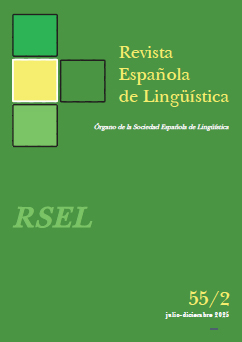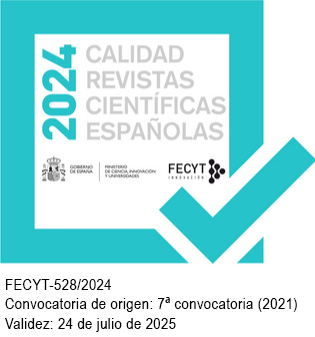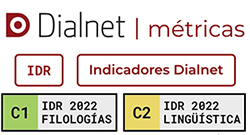Presupposition of Alternatives and Focal Particles: The Case of hasta ‘even’
doi: https://doi.org/10.31810/rsel.55.2.1
Keywords:
presupposition of existence; alternatives; focus particles; hasta.Abstract
This paper deals with some of the problems that focal hasta ‘even’ arises for the presupposition of alternatives associated with the focus. Although there are relevant studies of focal hasta that relate the occurrence of this particle with alternatives of the focused segment, the scholars have not paid attention to those factors that allow the speakers to satisfy (or not) the presupposition of alternatives. In order to study to what extent hasta allows interpreting the existence of alternatives of the focus, this paper is based on the analysis of examples from CORPES XXI (0.99 version). As will be shown, these samples attest cases of hasta that fails in the association of the focus with its possible alternatives. We will posit that these examples share some crucial properties, such as the sentential scope of the particle and the lack of alternatives mentioned in the immediate discourse, which is more frequent in oral texts. The explanation of these patterns is outside the scope of this paper, although we will point to the possibility that the semantics, the pragmatics, and the grammar of the particle play a crucial role. On the one hand, hasta has a complex semantics allowing that, in the case that the presupposition of alternatives is not satisfied, the presupposed information accommodates to the scalar-evaluative implicature, which is also induced by hasta. On the other hand, sentences under the scope of the particle are also complex types that do not easily allow establishing semantic associations with equivalent alternatives, even more if some of these alternatives are not mentioned in the immediate discourse.
Downloads
References
Albelda, M. (2014). Escalaridad y evaluación: rasgos caracterizadores de la intensificación pragmática. En E. Putska & S. Goldschmitt (Eds.), Emotionen, Expressivität, Emphase (pp. 79–94). Erich Schmidt Verlag.
Briz, A., Pons, S. & Portolés, J. (coords.) (2008). Diccionario de partículas discursivas del español [en línea]. Disponible en [última consulta 04/06/2022].
Calhoun, S. (2009). What makes a word contrastive? Prosodic, semantic and pragmatic perspectives. En D. Barth-Weingarten, N. Dehé & A. Wichmann (Eds.), Where prosody meets pragmatics (pp. 53–78). Emerald.
Dominicy, M. (1982). La evolución del español hasta en Hispanoamérica. Anuario de Letras, 20, 41–90.
Felíu, E. & Pato, E. (2022). Descripción y comparación de incluso e inclusive en español actual. Lengua y habla, 26, 55–86.
Fox, D. & Katzir, R. (2011). On the characterization of alternatives. Natural Language Semantics, 19, 87–107.
Gotzner, N. (2017). Alternative sets in language processing. How focus alternatives are represented in the mind. Palgrave Macmillan Cham.
Gotzner, N., Wartenburger, I. & Spalek, K. (2016). The impact of focus particles on the recognition and rejection of contrastive alternatives. Language and Cognition, 8, 59–95.
Husband, E. M. & Ferreira, F. (2016). The role of selection in the comprehension of focus alternatives. Language, Cognition and Neuroscience, 31(2), 217–235.
Kim, Ch., Gumlogson, Ch., Tanenhaus, M. K. & Runner, J. T. (2015). Context-driven expectations about focus alternatives. Cognition, 139, 28–49.
König, E. (1991). The meaning of focus particles: A comparative perspective. Routledge.
Loureda, Ó., Cruz, A., Recio, I. & Rudka, M. (2021). Comunicación, partículas discursivas y pragmática experimental. Arco-Libros.
Miyoshi, J.-N. (2015). La partícula española hasta y su función pragmática. Lingüística, 31(1), 7–23.
Portolés, J. (2007). Escalas informativas aditivas: pruebas del español. Spanish in Context, 4(2), 135–157.
Portolés, J. (2009). Alternativas convocadas por partículas discursivas. Español Actual, 92, 47–68.
Portolés, J. (2011). Las partículas focales desde una perspectiva polifónica. En H. Aschenberg & Ó. Loureda (Eds.), Marcadores del discurso: de la descripción a la definición (pp. 51–76). Iberoamericana.
RAE. Banco de datos (CORPES XXI) [en línea] (versión 0.99). Corpus del Español del Siglo XXI (CORPES). Disponible en <https://dle.rae.es> [última consulta 06/04/2022].
RAE. Diccionario panhispánico de dudas [en línea]. Disponible en <https://dle.rae.es> [última consulta 06/04/2022].
RAE y ASALE (2025). Nueva gramática de la lengua española, vol. II. Madrid: Espasa.
Rooth, M. E. (1985). Association with focus. Tesis doctoral. Amherst: University of Massachussets Amherst.
Rooth, M. E. (1992). A theory of focus interpretation. Natural Language Semantics, 1, 75–116.
Salazar, V. & Carretero, A. (2025). La cohesión en la Gramática Discursivo-Funcional: indagaciones a partir de la negación aditiva del español. Círculo de lingüística aplicada a la comunicación, 101, 257–270.
Sánchez, C. (1999). Los cuantificadores: clases de cuantificadores y estructuras cuantificativas. En I. Bosque & V. Demonte (Dirs.), Gramática descriptiva de la lengua española, vol. 1 (pp. 1025–1128). Espasa.
Torres, L. (2020). The scalar focus operator hasta: An experimental study on processing costs in Spanish. Tesis doctoral. Heidelberg: Universität Heidelberg.
Van der Sandt, R. (2012). Presupposition and accommodation in discourse. En K. Allan & K. Jaszczolt (Eds.), The Cambridge Handbook of Pragmatics (pp. 330-350). Cambridge University Press.
Published
How to Cite
Issue
Section
Copyright (c) 2025 Revista Española de Lingüística

This work is licensed under a Creative Commons Attribution-NonCommercial-NoDerivatives 4.0 International License.











